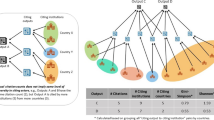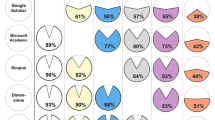Abstract
The economic and social need to spread knowledge between universities and industry has become increasingly evident in recent years. This paper presents a ranking based partly on research and knowledge transfer indicators from U-multirank data but using data-driven weights. The choice of specific weights and the comparison between ranks remain a sensitive topic. A restricted version of the benefit of the doubt method is implemented to build a new university ranking that includes an endogenous weighting scheme. Furthermore, a novel procedure is presented to compare the principal method with U-multirank. At the best of my knowledge, the U-multirank data set has been unapplied to achieve alternative rankings that include research and knowledge transfers dimensions. A significant result arises from the benefit of the doubt: the highest importance weight is assigned to the co-publications with industrial partners and interdisciplinary publication indicators. This paper fills a bit of the existing gap on the role of co-publications with industrial partners in the university efficiency around the world.

Source: Author. U-Multirank (2018)

Author. U-Multirank (2018)
Similar content being viewed by others
Notes
https://www.umultirank.org. Performance groups with numbers: A = 1, B = 2, C = 3, D = 4, and E = 5.
The logical function is =MATCH($A2;$C$2:$C$819;0). The MATCH function searches for a specified item in a range of cells, and then returns the relative position of that item in the range.For instance, if the range A1:A3 contains the values 5, 25, and 38, then the formula =MATCH(25,A1:A3,0) returns the number 2, because 25 is the second item in the range.
As an example for the BODR \(=IF\)(Y($\(C3>0\);$\(C3<=3\));”1”;IF(Y($\(C3>3\);$\(C3<=42\)); ”2”;IF(Y($\(C3>42\);$\(C3<=53\));”3”; IF(Y($\(C3>53\);$\(C3<=54\));”4”; IF(Y($\(C3>54\);$\(C3<=84\));”5”;IF(Y($\(C3>84\);$\(C3<=110\)); “6”;IF(Y($\(C3>110\);$\(C3<=112\)); “7”)))))))
References
Agasisti, T., Barra, C., & Zotti, R. (2019). Research, knowledge transfer and innovation: The effect of Italian universities’ efficiency on local economic development 2006–2012. Journal of Regional Science, 59(5), 819–849. https://doi.org/10.1111/jors.12427.
Agasisti, T., & Pérez-Esparrells, C. (2009). Comparing efficiency in a cross-country perspective: The case of Italian and Spanish state universities. Higher Education, 59(1), 85–103. https://doi.org/10.1007/s10734-009-9235-8.
Akoglu, H. (2018). User’s guide to correlation coefficients. Turkish Journal of Emergency Medicine, 18(3), 91–93. https://doi.org/10.1016/j.tjem.2018.08.001.
Barros, M. V., Ferreira, M. B., do Prado, G.F., Moro-Piekarski, C., & Picinin, C.T. (2020). The interaction between knowledge management and technology transfer: A current literature review between 2013 and 2018. The Journal of Technology Transfer. https://doi.org/10.1007/s10961-020-09782-w.
Bengoa, A., Maseda, A., Iturralde, T., & Aparicio, G. (2020). A bibliometric review of the technology transfer literature. The Journal of Technology Transfer,. https://doi.org/10.1007/s10961-019-09774-5.
Bougnol, M. L., & Dulá, J. H. (2014). Technical pitfalls in university rankings. Higher Education, 69(5), 859–866. https://doi.org/10.1007/s10734-014-9809-y.
Borge, L., & Bräring, S. (2017). Exploring effectiveness of technology transfer in interdisciplinary settings: The case of the bioeconomy. Creativity and Innovation Management, 26(3), 311–322. https://doi.org/10.1111/caim.12222.
Borge, L., & Bräring, S. (2018). What affects technology transfer in emerging knowledge areas? A multi-stakeholder concept mapping study in the bioeconomy. The Journal of Technology Transfer,. https://doi.org/10.1007/s10961-018-9702-4.
Bowman, N. A., & Bastedo, M. N. (2010). Anchoring effects in world university rankings: Exploring biases in reputation scores. Higher Education, 61(4), 431–444. https://doi.org/10.1007/s10734-010-9339-1.
Breschi, S., & Catalini, C. (2010). Tracing the links between science and technology: An exploratory analysis of scientists’ and inventors’ networks. Research Policy, 39(1), 14–26. https://doi.org/10.1016/j.respol.2009.11.004.
Carrión, A., Garía-Gutiérrez, V. R., Bas, M. C., & Carot, J. M. (2012). A new methodology for measuring third mission activities of universities. In INTED2012 proceedings (pp. 1218–1223). Retrieved October 01, 2020, from https://library.iated.org/view/CARRION2012ANE.
Chang Lee, K., Lee, S., & Kang, I. W. (2005). KMPI: Measuring knowledge management performance. Information and Management, 42(3), 469–482. https://doi.org/10.1016/j.im.2004.02.003.
Cherchye, L., Moesen, W., Rogge, N., & Van Puyenbroeck, T. (2007). An introduction to ‘Benefit of the doubt’ composite indicators. Social Indicators Research, 82, 111–145. https://doi.org/10.1007/s11205-006-9029-7.
Choudhry, V., & Ponzio, T. A. (2020). Modernizing federal technology transfer metrics. The Journal of Technology Transfer, 45, 544–559. https://doi.org/10.1007/s10961-018-09713-w.
Collins, F. L., & Park, G. (2016). Ranking and the multiplication of reputation: Reflections from the frontier of globalizing higher education. Higher Education, 72, 115–129. https://doi.org/10.1007/s10734-015-9941-3.
Crescenzi, R., Filippetti, A., & Iammarino, S. (2017). Academic inventors: Collaboration and proximity with industry. The Journal of Technology Transfer, 42, 730–762. https://doi.org/10.1007/s10961-016-9550-z.
David, S. A. (2018). The relationship between the third mission and university ranking: Exploring the outreach of the top ranked universities in BRICS countries. Retrieved October 01, 2020, from https://third-mission.org/files/publications2018/Third_mission_and_university_ranking_Solomon_A._David.pdf.
de Wit-de Vries, E., Dolfsma, W. A., van der Windt, H. J., & Gerkema, M. P. (2019). Knowledge transfer in university–industry research partnerships: A review. The Journal of Technology Transfer, 44, 1236–1255. https://doi.org/10.1007/s10961-018-9660-x.
De Witte, K., & Hudrlikova, L. (2013). What about excellence in teaching? A benevolent ranking of universities. Scientometrics, 96, 337–364. https://doi.org/10.1007/s11192-013-0971-2.
De Witte, K., & Rogge, N. (2010). To publish or not to publish? On the aggregation and drivers of research performance. Scientometrics, 85, 657–680. https://doi.org/10.1007/s11192-010-0286-5.
Etzkowitz, H., & Leydesdorff, L. (1999). The future location of research and technology transfer. Journal of Engineering and Technology Management, 24, 111–123. https://doi.org/10.1023/A:1007807302841.
Finne, H., Day, A., Piccaluga, A., Spithoven, A., Walter, P., & Wellen, D. (2011). A composite indicator for knowledge transfer. In Report from the European Commission’s expert group on knowledge transfer indicators. https://ec.europa.eu/research/innovation-union/pdf/kti-report-final.pdf.
Fisch, C. O., Hassel, T. M., Sandner, P. G., & Block, J. H. (2015). University patenting: A comparison of 300 leading universities worldwide. The Journal of Technology Transfer, 40, 318–345. https://doi.org/10.1007/s10961-014-9355-x.
Fombuena, A. (2019). Evaluación de la transferencia de conocimiento e innovación de las universidades españolas. Revista Española de Documentación Científica, 42(3), e240. https://doi.org/10.3989/redc.2019.3.1596.
Fusco, E., Vidoli, F., & Sahoo, B. K. (2018). Spatial heterogeneity in composite indicator: A methodological proposal. Omega, 77, 1–14. https://doi.org/10.1016/j.omega.2017.04.007.
Govind, M., & Küttim, M. (2016). International knowledge transfer from university to industry: A systematic literature review. Research in Economics and Business: Central and Eastern Europe, 8(2), 5–25.
Gupta, T., & Panda, S. P. (2019). Clustering validation of CLARA and K-means using Silhouette & DUNN measures on Iris dataset. In 2019 International conference on machine learning, big data, cloud and parallel computing (COMITCon). https://doi.org/10.1109/comitcon.2019.8862199.
Hermans, J. (2013). Knowledge transfer in or through clusters: Outline of a situated approach. Advances in Spatial Science,. https://doi.org/10.1007/978-3-642-33194-7_3.
Ho, M. H. C., Liu, J. S., Lu, W. M., & Huang, C. C. (2013). A new perspective to explore the technology transfer efficiencies in US universities. The Journal of Technology Transfer, 39(2), 247–275. https://doi.org/10.1007/s10961-013-9298-7.
Holgersson, M., & Aaboen, L. (2019). A literature review of intellectual property management in technology transfer offices: From appropriation to utilization. Technology in Society, 59, 101132. https://doi.org/10.1016/j.techsoc.2019.04.008.
Huang, M., Yang, H., & Chen, D. (2015). Industry-academia collaboration in fuel cells: A perspective from paper and patent analysis. Scientometrics, 105, 1301–1318. https://doi.org/10.1007/s11192-015-1748-6.
Johnes, J. (2018). University rankings: What do they really show? Scientometrics, 115, 585–606. https://doi.org/10.1007/s11192-018-2666-1.
Landinez, L., Kliewe, T., & Diriba, H. (2019). Entrepreneurial University indicators in global university rankings. In Developing engaged and entrepreneurial universities. Theories, concepts and empirical findings (pp. 57–86). https://doi.org/10.1007/978-981-13-8130-0.
Lee, J., Vance, H., Stensaker, B., & Ghosh, S. (2020). Global rankings at a local cost? The strategic pursuit of status and the third mission. Comparative Education, 56(2), 236–256. https://doi.org/10.1080/03050068.2020.1741195.
Marhl, M., & Pausits, A. (2011). Third mission indicators for new ranking methodologies. Evaluation in Higher Education, 5(1), 43–64.
Moed, H. F. (2017). A critical comparative analysis of five world university rankings. Scientometrics, 110, 967–990. https://doi.org/10.1007/s11192-016-2212-y.
Montesinos, P., Carot, J. M., Martinez, J. M., & Mora, F. (2008). Third mission ranking for world class universities: Beyond teaching and research. Higher Education in Europe, 33(2–3), 259–271. https://doi.org/10.1080/03797720802254072.
Mukherji, N., & Silberman, J. (2019). Knowledge flows between universities and industry: The impact of distance, technological compatibility, and the ability to diffuse knowledge. The Journal of Technology Transfer,. https://doi.org/10.1007/s10961-019-09770-9.
OECD. (2004). The OECD-JRC handbook on practices for developing composite indicators. In The OECD committee on statistics, Conference, 7–8 June 2004. OECD, Paris. https://stats.oecd.org/glossary/detail.asp?ID=6278.
Olcay, G. A., & Bulu, M. (2017). Is measuring the knowledge creation of universities possible? A review of university rankings. Technological Forecasting and Social Change, 123, 153–160. https://doi.org/10.1016/j.techfore.2016.03.029.
Perez-Esparrells, C., & Orduna-Malea, E. (2018). Do the technical universities exhibit distinct behaviour in global university rankings? A Times Higher Education (THE) case study. Journal of Engineering and Technology Management, 48, 97–108. https://doi.org/10.1016/j.jengtecman.2018.04.007.
Ramos-Vielba, I., & Fernández-Esquinas, M. (2011). Beneath the tip of the iceberg: Exploring the multiple forms of university-industry linkages. Higher Education, 64(2), 237–265. https://doi.org/10.1007/s10734-011-9491-2.
Rossi, F., & Rosli, A. (2014). Indicators of university-industry knowledge transfer performance and their implications for universities: Evidence from the United Kingdom. Studies in Higher Education, 40(10), 1970–1991. https://doi.org/10.1080/03075079.2014.914914.
Safón, V. (2019). Inter-ranking reputational effects: An analysis of the Academic Ranking of World Universities (ARWU) and the Times Higher Education World University Rankings (THE) reputational relationship. Scientometrics, 121, 897–915. https://doi.org/10.1007/s11192-019-03214-9.
Shehatta, I., & Mahmood, K. (2016). Correlation among top 100 universities in the major six global rankings: Policy implications. Scientometrics, 109, 1231–1254. https://doi.org/10.1007/s11192-016-2065-4.
Schmoch, U. (1993). Tracing the knowledge transfer from science to technology as reflected in patent indicators. Scientometrics, 26, 193–211. https://doi.org/10.1007/BF02016800.
Sun, Y., Zhang, C., & Kok, R. A. W. (2020). The role of research outcome quality in the relationship between university research collaboration and technology transfer: Empirical results from China. Scientometrics, 122, 1003–1026. https://doi.org/10.1007/s11192-019-03330-6.
Szuwarzyński, A. (2019). Benefit of the doubt approach to assessing the research performance of Australian universities. Higher Education Quarterly, 73, 235–250. https://doi.org/10.1111/hequ.12184.
U-Mulirank. (2018). Indicator book. Press Media. Retrieved September 09, 2019, from https://www.umultirank.org/export/sites/default/press-media/documents/Indicator-Book-2018.pdf.
Uslu, B. (2020). A path for ranking success: What does the expanded indicator-set of international university rankings suggest? Higher Education,. https://doi.org/10.1007/s10734-020-00527-0.
Van Puyenbroeck, T. (2018). On the output orientation of the benefit-of-the-doubt-model. Social Indicators Research, 139, 415–431. https://doi.org/10.1007/s11205-017-1734-x.
van Vught, F., & Ziegele, F. (Eds.). (2011). Design and testing the feasibility of a multidimensional global university ranking. In Final Report: Consortium for Higher Education and Research Performance Assessment, CHERPA-Network. Retrieved October 01, 2020, from https://ris.utwente.nl/ws/portalfiles/portal/5145063/Vught11umulti.pdf.
Vidoli, F., & Fusco, E. (2018). Compind: Composite indicators functions based on frontiers in R. R package version 2.0. Retrieved January 9, 2020, from https://cran.r-project.org/web/packages/Compind/vignettes/Compind_vignette.pdf.
Vidoli, F., & Mazziotta, C. (2013). Robust weighted composite indicators by means of frontier methods with an application to european infrastructure endowment. Statistica Applicata-Italian Journal of Applied Statistics, 23(2), 259–282.
Wang, X., Zhao, Y., Liu, R., & Zhang, J. (2013). Knowledge-transfer analysis based on co-citation clustering. Scientometrics, 97, 859–869. https://doi.org/10.1007/s11192-013-1077-6.
Waaijer, C. J. F. (2018). Why the public nature of university rankings torpedoes their value for benchmarking: An institutional researcher’s opinion. In Proceedings of the 23rd international conference on science and technology indicators (STI 2018). Retrieved September 09, 2019, from http://sti2018.cwts.nl/proceedings.
Wiel, van de, M. A., & Di Bucchianico, A. (1998). Fast computation of the exact null distribution of Spearman’s rho and Page’s L statistic for samples with and without ties. (Memorandum COSOR; Vol. 9817). Eindhoven: Technische Universiteit Eindhoven.
Acknowledgements
Thanks to U-multirank consortium for generously providing the official database for this academic paper. I want to thank the anonymous referees for their valuable comments which helped to improve the manuscript.
Author information
Authors and Affiliations
Corresponding author
Ethics declarations
Conflict of interest
The author declares that he has no conflict of interest.
Rights and permissions
About this article
Cite this article
Dip, J.A. What does U-multirank tell us about knowledge transfer and research?. Scientometrics 126, 3011–3039 (2021). https://doi.org/10.1007/s11192-020-03838-2
Received:
Accepted:
Published:
Issue Date:
DOI: https://doi.org/10.1007/s11192-020-03838-2













